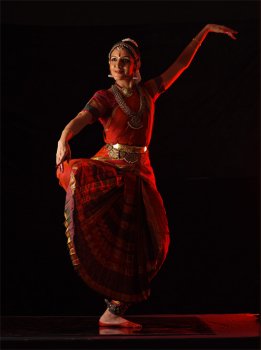
Lavanya
Ananth's recital replete with impeccable movement
- Kalyani
Giri
e-mail: kalyanikgiri@yahoo.com
May 31, 2011
With
a performance born of soulful spirituality and an intrinsic understanding
of her craft, accomplished young award-winning dancer from Chennai, Lavanya
Ananth enchanted a capacity audience in Houston at the Kaplan Theater,
Jewish Community Center, with an outstanding Bharatanatyam recital. Jointly
hosted by three local organizations Bharathi Kalai Manram, Samarpanam and
Silambam on May 22, 2011, the presentation Nrithya Samarchitha meaning
An offering through Dance, bore testimony to Ananth's prowess as
a choreographer of note and was a study in the adherence to tradition,
lyrical grace, and eloquent facial expression. Ananth's visit to this city
was part of her nationwide concert/workshop tour; traveling with her was
a formidably gifted live orchestra, also from Chennai, whose artistic cohesion
with the dancer made for a culturally enriching experience. A disciple
of luminaries in the exalted ilk of SK Rajarathnam Pillai and Guru KJ Sarasa
in the majestic Vazhuvoor style of dance, Ananth also came under the expert
tutelage of the doyen of abhinaya, Kalanidhi Narayanan.

Ananth began
with Nrityanjali followed by the Amba Sthuti that described
the goddess Devi in all her winsome beauty and incarnations. Replete with
arresting poses and meticulous hand and foot movements, Amba Sthuti
accorded the dancer a broad landscape to showcase her finesse at abhinaya.
Ananth's next piece, Swamiye Azhaithodi Vaadi, an exacting varnam
penned by the maestro KN Dandayuthapani Pillai, told of a maiden's yearning
to be united with her beloved Lord Nataraja, the Cosmic Dancer. Through
a complex lexicon of expressions and hand gestures, the heroine cajoled,
begged, and scolded her friend to hasten her on her way to bring Lord Nataraja
to her. Interspersed with interludes of pure dance in impeccable rhythm,
and excerpts of elaborate storytelling, the dancer drew parallels between
the heroine's longing for her celestial lover and the soul's yearning for
salvation. The dancer's poetic interpretation of the varnam drew attention
to the hypnotic timbre of vocalist Murali Parthasarathy's voice as he segued
through the garland of ragas effortlessly and empathetically.
The Devarnama
was an engaging composition by poet Purandara Dasa telling of the gopis'
many questions regarding the divine child god Krishna. Was he really a
child, they pondered? How could that be when he flirted with them and asked
impertinent questions that discomfited them? Perplexed, the gopis discuss
Krishna, telling of his mischievousness and oftentimes risqué behavior.
Then one of the gopis reveals that Krishna appeared to her as Lord Purandara
Vittala, the deity of the village and a form of Lord Vishnu. The towering
Ardhanarishvara Sthuti vividly displayed Ananth's felicity for conveying
moods and emotions through the whisper of a smile or the errant lift of
a brow. In her portrayal of the composite androgynous form of Lord Shiva
and his consort Parvati, Ananth dramatically articulated the glowing, scented,
melting grace of Parvati in contrast to the vigor, energy, and ash-smeared
Shiva. She ended her recital with the rousingly patriotic ode to India,
Vande Mataram, and drew a standing ovation from an audience of art
lovers and respected classical dance teachers in this city.
A critically
acclaimed dancer, Ananth ranks among the dance elite in India today, a
status very tough to achieve in the competitive field of the arts. Among
many honors, she was a recipient of the prestigious Ustad Bismillah Khan
Yuva Puraskar award from the Sangeet Natak Akademi in 2007. Her inordinately
gifted accompanists along with vocalist Parthasarathy included nattuvanaar
S Srilata, violinist R Kalaiarasan, and mridangist MS Sukhi who created
the music arrangements for the performance. Seated proudly in the audience
was Houston-based medical doctor Shobana Chandrasekhar, Ananth's older
sister, also a gifted dancer; back home in Chennai, the sisters often performed
together.

Response
June 4, 2011
I have a
few questions for Kalyani Giri.
What is "felicity
for conveying moods"? How can we establish its presence?
How does she
see whether a performance is born of soulful spirituality or of something
else?
What were the
signs that the capacity audience at the Kaplan Theater was enchanted?
In what was
Lavanya's performance outstanding. What exactly was there in An offering
through Dance that bore testimony to Ananth's prowess as a choreographer
of note?
What were Lavanya's
most memorable eloquent facial expressions, and where are these photos
(or videos)? What exactly showed her finesse at abhinaya?
What were the
arresting poses?
What is the
difference between a formidably gifted orchestra and merely a gifted orchestra?
What is the difference between "formidably gifted" and "inordinately gifted"?
How can we see it?
Who else does
she consider as "luminaries in the exalted ilk"? How did the ilk become
exalted and the luminaries start to shine?
Are other Bharatanatyam
banis less majestic? What is there particularly majestic in the Vazhuvoor
style?
Did she succeed
in portraying the maiden's yearning to be united with her beloved Lord
Nataraja, and whether she was using any of the 108 karanas that Nararaja
is seen in? How did she manage to do it at Murali Parthasarathy's voice
despite Bharata Muni's indication that only women vocalists should accompany
dance performances?
What makes
a dancer "critically acclaimed"? Who are the ones who rank among the dance
elite in India today?
Can a dancer
(like me) whose face may not qualify for being published in fashion magazines
successfully portray Devi in all her winsome beauty?
Thank you for
clarifying my humble doubts.
Ashwini Shankar
ashwini.shankar@live.com |





